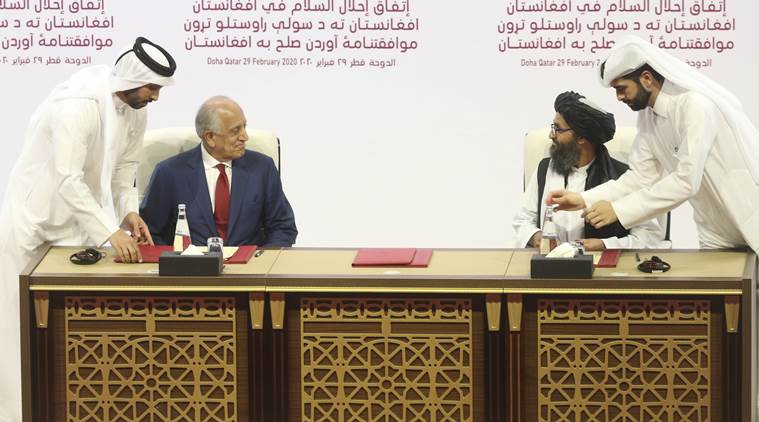Note4Students
From UPSC perspective, the following things are important :
Prelims level: Not Much
Mains level: US-Taliban pact and its implications on India-Afghanistan relationship

- The US and Taliban signed an agreement for “Bringing Peace to Afghanistan”, which will enable the US and NATO to withdraw troops in the next 14 months.
- The pact is between the “Islamic Emirate of Afghanistan which is not recognized by the United States as a state and is known as the Taliban” and the US.
- The four-page pact was signed between Zalmay Khalilzad, US Special Representative for Afghanistan Reconciliation, and Mullah Abdul Ghani Baradar, political head of the Taliban.
Key elements of the deal
Troops Withdrawal
- The US will draw down to 8,600 troops in 135 days and the NATO or coalition troop numbers will also be brought down, proportionately and simultaneously.
- And all troops will be out within 14 months — “all” would include “non-diplomatic civilian personnel” (could be interpreted to mean “intelligence” personnel).
Taliban Commitment
- The main counter-terrorism commitment by the Taliban is that “It will not allow any of its members, other individuals or groups, including al-Qaeda, to use the soil of Afghanistan to threaten the security of the US and its allies”.
- While Miller said the reference to al-Qaeda is important, the pact is silent on other terrorist groups — such as anti-India groups Lashkar-e-Toiba or Jaish-e-Mohammed.
- Again, India, not being an US ally, is not covered under this pact.
Sanctions Removal
- UN sanctions on Taliban leaders to be removed by three months (by May 29) and US sanctions by August 27.
- The sanctions will be out before much progress is expected in the intra-Afghan dialogue.
Prisoner’s release
- This is a possible trouble spot because the US-Taliban agreement and the joint declaration differ, and it is not clear whether the Ashraf Ghani-led government is on board with this big up-front concession to Taliban.
- The joint declaration says the US will facilitate discussion with Taliban representatives on confidence building measures, to include determining the feasibility of releasing significant numbers of prisoners on both sides.
- While there are no numbers or deadlines in the joint declaration, the US-Taliban pact says up to 5,000 imprisoned Taliban and up to 1,000 prisoners from “the other side” held by Taliban “will be released” by March.
- The intra-Afghan negotiations are supposed to start in Oslo.
Ceasefire
- This is identified as another potential “trouble spot”.
- The agreement states ceasefire will be simply “an item on the agenda” when intra-Afghan talks start, and indicate actual ceasefire will come with the “completion” of an Afghan political agreement.
Implications of the Deal
An adieu to democracy in Afghanistan
- The Taliban have got what they wanted: troops withdrawal, removal of sanctions, release of prisoners.
- This has also strengthened Pakistan, Taliban’s benefactor, and the Pakistan Army and the ISI’s influence appears to be on the rise.
- It has made it unambiguous that it wants an Islamic regime.
- The Afghan government has been completely sidelined during the talks between the US and Taliban.
- The future for the people of Afghanistan is uncertain and will depend on how Taliban honours its commitments and whether it goes back to the mediaeval practices of its 1996-2001 regimes.
Implications for India
- India has been backing the Ghani-led government and was among very few countries to congratulate Ghani on his victory.
- India’s proximity to Ghani also drew from their shared view of cross-border terrorism emanating from Pakistan.
- There has not been formal contact with top Taliban leaders, the Indian mission has a fair amount of access to the Pashtun community throughout Afghanistan through community development projects of about $3 billion.
- Due to So, although Pakistan military and its ally Taliban have become dominant players in Kabul’s power circles, South Block insiders insist that it is not all that grim for New Delhi.
- these high-impact projects, diplomats feel India has gained goodwill among ordinary Afghans, the majority of whom are Pashtuns and some may be aligned with the Taliban as well.
Way Forward
- The joint declaration is a symbolic commitment to the Afghanistan government that the US is not abandoning it.
- Much will depend on whether the US and the Taliban are able to keep their ends of the bargain, and every step forward will be negotiated, and how the Afghan government and the political spectrum are involved.
- Like in 1989, 1992, 1996, and in 2001, Pakistan has the opportunity to play a constructive role. It frittered away the opportunities in the past.
Back2Basics
India and the Taliban
- India and the Taliban have had a bitter past.
- New Delhi nurses bitter memories from the IC-814 hijack in 1999, when it had to release terrorists — including Masood Azhar who founded Jaish-e-Mohammed that went on to carry out terror attacks as such on Parliament, Pathankot and in Pulwama.
- Quite predictably, Mullah Baradar did not name India among the countries that supported the peace process, but specially thanked Pakistan for the “support, work and assistance” provided.
- The Taliban perceived India as a hostile country, as India had supported the anti-Taliban force Northern Alliance in the 1990s.
- India never gave diplomatic and official recognition to the Taliban when it was in power during 1996-2001.
- But its foreign policy establishment has shied away from engaging with the Taliban directly.
Get an IAS/IPS ranker as your 1: 1 personal mentor for UPSC 2024
